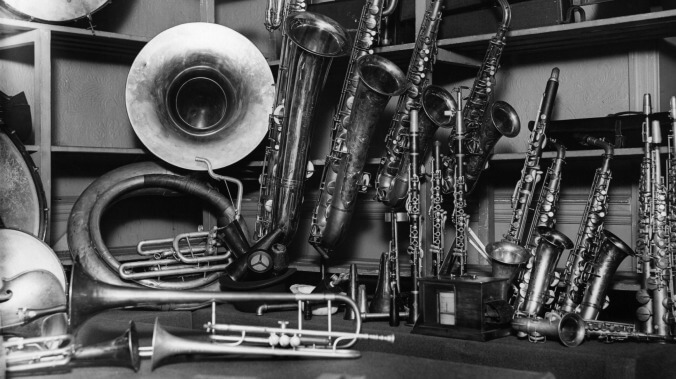Photo: Topical Press Agency/Getty Images
This week’s entry: Adolphe Sax
What it’s about: The inventor of the saxotromba! Also, the saxtuba, saxhorn, and more consequentially, the saxophone. Name enough things after yourself, and eventually one of them is going to stick.
Strangest fact: Sax barely made it to adulthood. His mother called him “a child condemned to misfortune,” and his neighbors called him “the ghost.” Over the course of one eventful childhood, young Adolphe fell from a height of three stories and hit his head on a stone; was later hit in the head by a falling cobblestone; drank sulfuric acid; nearly suffocated when freshly varnished items were kept in his bedroom; was burnt in a gunpowder explosion; was burnt after falling onto a cast-iron pan; and nearly drowned in a river. Somehow this Rasputin-like childhood didn’t carry on into his adulthood; as far as we know, he lived a long, healthy life, dying at the ripe old age (for the 1800s, certainly) of 79.
Thing we were happiest to learn: Sax could invent instruments like nobody’s business. His parents designed and built instruments, notably improving on the design of the French horn. Young Adolphe was eager to follow in their footsteps, entering two flutes and a clarinet of his own design into a competition when he was just 15. By 24, he had patented an improved bass clarinet. Two years later, he invented a valved bugle that became known as the saxhorn. The saxhorn came in seven sizes (most wind instruments have soprano, alto, tenor, and baritone variations; Sax added variants like contrabass and sopranino, and at one point there may have been as many as 10 different saxhorns). Three of those are still in use today—the trumpet-like flugelhorn (soprano saxhorn), baritone (sax)horn (which resembles a small tuba), and the lesser-known tenor (sax)horn.
Thing we were unhappiest to learn: Sax didn’t live to see the saxophone become a staple of everything from bebop to yacht rock. After the instrument was invented in the 1840s, military bands quickly embraced this new instrument that could play complicated runs of notes as easily as a clarinet and project as loudly as a trumpet. However, orchestra composers and conductors never took to the sax. Nor did rival instrument makers, several of whom either sued Sax for patent infringement or tried to delegitimize the patents he held. Legal battles over his designs dragged on for 20 years, and he was driven into bankruptcy three times. He died in poverty, never dreaming that when humanity eventually achieved musical perfection, it would come in the form of the saxophone riff from “Baker Street.”
Also noteworthy: Sax invented a few more instruments that didn’t catch on. The saxotromba had three valves like a trumpet, but a bell that pointed upwards, and a long pipe that looped underneath the instrument. It was essentially a marching French horn, and was used as such by French military bands for around 25 years before falling out of favor. Sax also invented the six-piston trombone, which looks like a regular trombone that can only be played standing up because of the extra loops of pipe drooping down to the floor. (The instrument doesn’t have its own page, and no information is given about it, but the photo is a doozy.)
Best link to elsewhere on Wikipedia: Sax’s birthplace, in Dinant, Belgium, has been turned into a museum called Mr Sax’s House. The museum has a collection of his instruments, and the Wiki page has a bit more information on Sax. While he died in poverty, in his prime he supplied instruments to not only the French army but the Dutch as well (the Netherlands ruled over Belgium at the time), and ran an instrument factory that employed over 200 workers.
Further down the Wormhole: One early champion of Sax’s work was Romantic composer Hector Berlioz, who arranged one of his works for a saxhorn ensemble almost as soon as the instruments were invented. Berlioz was French, but was so impressed by performances of Hamlet and Romeo And Juliet that he learned English just so he could read Shakespeare. He also obsessively pursued Irish Shakespearean actress Harriet Smithson, until, like the ending of an 1980s comedy, his relentless stalking paid off and she agreed to marry him.
While we bemoan the rise of “franchise films,” as if it’s a new phenomenon, Shakespeare pre-empted cinematic universes, with Richard II; Henry IV, Part 1 and 2; and Henry V forming a series with a fair amount of connective tissue. Those four plays cover the English monarchy during the Hundred Years’ War. In the first, and least popular of the series, Richard II is undone by being arbitrary and indecisive, and faces a rebellion led by the Duke of Hereford, who would eventually become Henry IV. But before the events of the play, Richard faced Peasants’ Revolt in 1381, a nationwide uprising in which a populace still reeling from the Black Death rebelled against being overtaxed to pay for the Hundred Years’ War against France. It was the biggest revolt since the St Scholastica Day Riot, in 1355, in which two students’ complaining about a tavern’s wine led to nearly 100 deaths and the founding of Cambridge University. We’ll look at the original Animal House next week.

